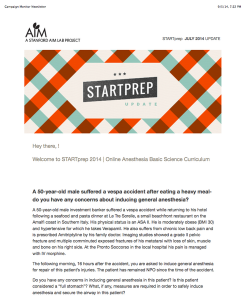
An email message with a “hook” employs a concise, narrative-driven scenario to motivate students to log into an online course. These email messages have a provocative subject heading that summarizes a specific real life situation where learners would need to apply the content covered in that installment of the online course. When the learner opens the email message, they are presented with a 1-2 paragraph open-ended scenario related to the lesson or module being released in the online course. This is followed by a trigger question such as “What would you do?” and then an invitation to “Uncover the answer by completing today’s module” that hyperlinks directly to the course LMS. The module’s learning objectives can also be included in the email message.
Emails can be programmed using an email client like Campaign Monitor or Mail Chimp so that they are sent at regular intervals timed with the release of content on the LMS. These same email clients can also be used to monitor click-through rates and assess the efficacy of particular scenarios or “hooks” at motivating students to log into the course.
Scenario-based education motivates learners by triggering direct connections between educational content and their own lived realities. Cases, vignettes or scenario-based prompts have been employed across disciplines to bridge theoretical knowledge with practical applications. By transmitting a sense of immediacy and vividness, scenarios or vignettes enable learners to “feel more directly implicated in what we read and understand” (Menkel-Meadow, 2000, p. 792). When students connect new scenarios to their own prior knowledge, learning has been found to be more profound and lasting (Ritchie & Hoffman, 1997).
Several criteria can be used to formulate particularly compelling or motivating scenarios or vignettes to embed in email messages. Recommended criteria include:
- Ambiguous & Open-Ended – Scenarios should not present an immediately obvious or correct answer, but rather should embody complexity sot that a learner is prompted to explore further
- Immediate & Actionable – Scenarios should convey a sense of immediacy and openings/cues/triggers that prompt the learner to click through to course content
- Contextualized & Situated – Scenarios should be set in a situation or context that is relatable and intrinsically interesting to learners
- Connected to Prior Knowledge – Scenarios should allow opportunities for multiple types of knowledge to be incorporated as resources
- Extrapolation-Enabling – Scenarios should lends themselves to extrapolation or generalization to other similar scenarios or classes of scenarios
- Insight-Producing – Scenarios should lead to insights that confirm opinions, alter opinions, reveal inadequacy in current principles, illuminate difficulties in proposed approach, or suggest new information to be pursued
Link to example artifact(s)

The Stanford AIM Lab created a daily online course to prepare anesthesia residents for competency in basic sciences. Each day contained a new chapter covering a basic science topic and authors also wrote corresponding scenarios or “clinical vignettes” that situated the topic by providing a real life example residents might face in the operating room. These scenarios or vignettes were programmed as the opening section of a daily email message that was sent out using the Campaign Monitor email client. The scenarios were followed by a direct link to the Moodle LMS where the course was hosted. Residents received the emails on a daily basis and then had a direct behavioral trigger prompting them to log into the online course and complete their daily module.
Link to scholarly reference(s)
Dolmans, D.H., deGrave, W., Wolfhagen, I.H., & van der Kleuten, C.P. (2005). Problem‐based learning: Future challenges for educational practice and research. Medical Education 39(7), 732-741.
Drummond-Young, M., & Mohide, E. (2001). Developing problems for use in problem-based learning. Transforming Nursing Education Through Problem-based Learning (165-191). Boston: Jones and Bartlett.
Menkel-Meadow, C. (2000). Telling stories in school: Using case studies and stories to teach legal ethics. Fordham L. Rev. 69, 787.
Mostert, M. (2007). Challenges of case-based teaching. Behavior Analyst Today 8(4), 434-442.
Raju, P. K., & Sankar, C. (1999). Teaching real‐world issues through case studies. Journal of Engineering Education 88(4), 501-508.
Rideout, E. (2001). Transforming nursing education through problem-based learning. Jones & Bartlett Learning.
Ritchie, D., & Hoffman, B. (1997). Using multimedia to overcome the problems with problem based learning. Instructional Science, 25(2), 97-115.
Shulman, J., ed., Case methods in teacher education. (1992) New York: Teachers College Press.
Ahearn, A., Chu, L., Fuller, A., Piehl, E., & Chandrasoma, J. (2015). Email messages with a “hook” that prompts logging in. In B. Chen & K. Thompson (Eds.), Teaching Online Pedagogical Repository. Orlando, FL: University of Central Florida Center for Distributed Learning. https://topr.online.ucf.edu/email-messages-with-a-hook-or-scenario-that-prompts-logging-into-an-online-course/.